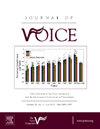epstral频谱声学分析用于发音障碍严重程度分类的研究
IF 2.5
4区 医学
Q1 AUDIOLOGY & SPEECH-LANGUAGE PATHOLOGY
引用次数: 0
摘要
目的:之前的研究已经指出了epstral 测量在评估发音障碍方面的优势。然而,在确定发音障碍严重程度方面,epstral 分析的结果并不明确。本研究的目的是确定表谱峰值突出度、表谱峰值突出度标准偏差、低频/高频比、低频/高频比标准偏差和表谱频谱指数的临界值,以预测土耳其语人群的嗓音严重程度,并确认这些临界值的鉴别力:研究对象包括 195 名嗓音失调患者和同等数量的年龄和性别匹配的无嗓音失调患者。所纳入的受试者在 2017 年 1 月至 2021 年 9 月期间曾到哈杰泰佩大学医院言语和语言治疗部进行嗓音评估。所有受试者的语音记录包括六个 CAPE-V/Turkish 句子和持续元音 /a/。三名评分员使用 GRBAS 量表(等级)和 CAPE-V/Turkish 的总体严重程度对语音样本进行听觉感知评分。根据听觉评估结果,参试者被分为正常组和轻度、中度和重度发音障碍组。使用 "语音和嗓音发音障碍分析"(ADSV)软件进行epstral频谱声学分析:结果:在持续元音语境中,除轻度与中度发音障碍组外,CSID 值的曲线下面积(ROC)均大于 0.8。在连贯言语语境中,CPP 值的 ROC 也大于 0.8,正常与轻度发音障碍组除外。CPP 和 CSID 的临界值在预测嗓音严重程度方面表现出较高的灵敏度和特异性:结论:预测嗓音严重程度的参数临界值对土耳其语人群嗓音严重程度的分类具有显著的鉴别力。本文章由计算机程序翻译,如有差异,请以英文原文为准。
Investigation of the Cepstral Spectral Acoustic Analysis for Classifying the Severity of Dysphonia
Objectives
The advantages of cepstral measurements in the evaluation of dysphonia have been noted in previous studies. However, there is an unclarity regarding the results of cepstral analyzes effect in determining the severity of dysphonia. The aims of this study were to determine the cut-off values of cepstral peak prominence, cepstral peak prominence standard deviation, low frequency/ high frequency ratio, low frequency/high frequency ratio standard deviation, and cepstral spectral index of dysphonia for predicting the voice severity within a Turkish speaking population, as well as to confirm the discriminative power of these cut-off values.
Materials Methods
One hundred ninety-five individuals with voice disorders and an equal number of age and gender-matched individuals without voice disorders were included. Included subjects had visited the Hacettepe University Hospitals Speech and Language Therapy Department for voice evaluation between January 2017 and September 2021. The voice recordings from all participants included the six CAPE-V/Turkish sentences and sustained vowel /a/. Three raters provided auditory perceptual ratings of the voice samples using the GRBAS scale (grade) and overall severity for the CAPE-V/Turkish. Participants were categorized into normal and mild, moderate, and severely dysphonic groups based on the auditory perceptual evaluation. Analysis of Dysphonia in Speech and Voice (ADSV) software was used for cepstral spectral acoustic analysis.
Results
In the sustained vowel context, the area under the curve (ROC) for the CSID value was >0.8, except for mild vs. moderate dysphonia groups. In connected speech contexts, the ROC of the CPP value was also >0.8, except for normal vs. mild dysphonia groups. The cut-off values of CPP and CSID demonstrated high sensitivity and specificity for predicting voice severities.
Conclusion
The cut-off values for the parameters that predicted voice severities showed a significant degree of discriminative power for categorizing voice severities among Turkish-speaking people.
求助全文
通过发布文献求助,成功后即可免费获取论文全文。
去求助
来源期刊

Journal of Voice
医学-耳鼻喉科学
CiteScore
4.00
自引率
13.60%
发文量
395
审稿时长
59 days
期刊介绍:
The Journal of Voice is widely regarded as the world''s premiere journal for voice medicine and research. This peer-reviewed publication is listed in Index Medicus and is indexed by the Institute for Scientific Information. The journal contains articles written by experts throughout the world on all topics in voice sciences, voice medicine and surgery, and speech-language pathologists'' management of voice-related problems. The journal includes clinical articles, clinical research, and laboratory research. Members of the Foundation receive the journal as a benefit of membership.
 求助内容:
求助内容: 应助结果提醒方式:
应助结果提醒方式:


